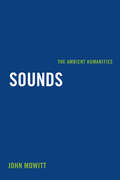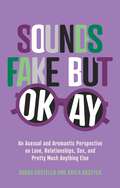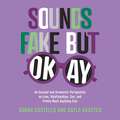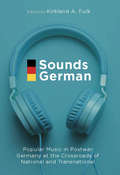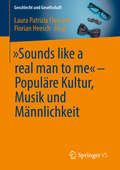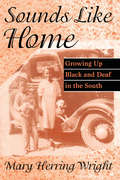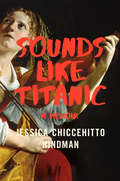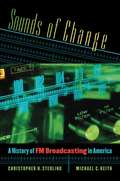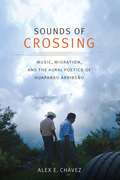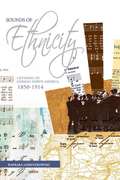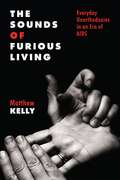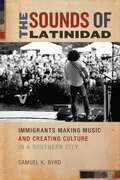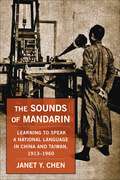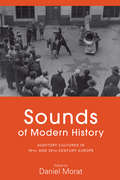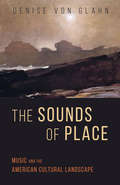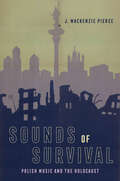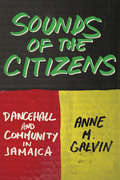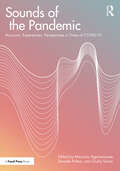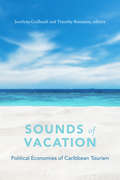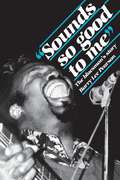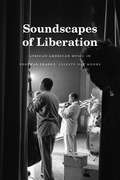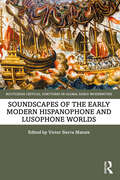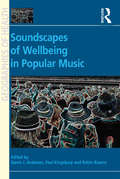- Table View
- List View
Sounds
by John MowittThis is not a book about sound. It is a study of sounds that aims to write the resonance and response they call for. John Mowitt seeks to critique existing models in the expanding field of sound studies and draw attention to sound as an object of study that solicits a humanistic approach encompassing many types of sounds, not just readily classified examples such as speech, music, industrial sounds, or codified signals. Mowitt is particularly interested in the fact that beyond hearing and listening we "audit" sounds and do so by drawing on paradigms of thought not easily accommodated within the concept of "sound studies." To draw attention to the ways in which sounds often are not perceived for the social and political functions they serve, each chapter presents a culturally resonant sound--including a whistle, an echo, a gasp, and silence--to show how sounds enable critical social and political concepts such as dialogue, privacy, memory, social order, and art-making. Sounds: The Ambient Humanities significantly engages, provokes, and contributes to the dynamic field and inquiry of sound studies.
Sounds Fake But Okay: An Asexual and Aromantic Perspective on Love, Relationships, Sex, and Pretty Much Anything Else
by Sarah Costello Kayla Kaszyca'Somehow, over time, we forgot that the rituals behind dating and sex were constructs made up by human beings and eventually, they became hard and fast rules that society imposed on us all.'True Love. Third Wheels. Dick pics. 'Dying alone'. Who decided this was normal?Sarah and Kayla invite you to put on your purple aspec glasses - and rethink everything you thought you knew about society, friendship, sex, romance and more.Drawing on their personal stories, and those of aspec friends all over the world, prepare to explore your microlabels, investigate different models of partnership, delve into the intersection of gender norms and compulsory sexuality and reconsider the meaning of sex - when allosexual attraction is out of the equation.Spanning the whole range of relationships we have in our lives - to family, friends, lovers, society, our gender, and ourselves, this book asks you to let your imagination roam, and think again what human connection really is. Includes exclusive 'Sounds Fake But Okay' podcast episodes.
Sounds Fake But Okay: An Asexual and Aromantic Perspective on Love, Relationships, Sex, and Pretty Much Anything Else
by Sarah Costello Kayla Kaszyca'Somehow, over time, we forgot that the rituals behind dating and sex were constructs made up by human beings and eventually, they became hard and fast rules that society imposed on us all.'An empowering guide to help aspec people become more confident in their identities and understand their relationships, written by the hosts of the #1 podcast on asexuality.True Love. Third Wheels. Dick pics. 'Dying alone'. Who decided this was normal?Sarah and Kayla invite you to put on your purple aspec glasses - and rethink everything you thought you knew about society, friendship, sex, romance and more.Drawing on their personal stories, and those of aspec friends all over the world, prepare to explore your microlabels, investigate different models of partnership, delve into the intersection of gender norms and compulsory sexuality and reconsider the meaning of sex - when allosexual attraction is out of the equation.Spanning the whole range of relationships we have in our lives - to family, friends, lovers, society, our gender, and ourselves, this book asks you to let your imagination roam, and think again what human connection really is. Includes exclusive 'Sounds Fake But Okay' podcast episodes.(P)2023 Hodder & Stoughton Limited
Sounds & Furies: The Love-Hate Relationship between Women and Slang
by Jonathon Green'When it comes to distaff dirtiness, mainstream males such as Dickens and Dekker make easy pickings, but Green finds the greatest treasures when he mudlarks on the margins. In Sounds & Furies, he has dredged up some gems.'Emma Byrne, Spectator'From fishwives to flappers and from music hall performers to Mumsnetters, women have indeed made contributions to the slang vocabulary of English; by bringing together so much fascinating material about their words and their worlds, this book makes its own contribution to the history of both women and language.'Professor Deborah Cameron, Professor of Language and Communication, Worcester College, University of Oxford'Green comprehensively disproves that slang is inherently masculine. Mumsnetters and bulldaggers, flappers and slappers, shicksters and hash-slingers all put in their claims as slang-users in their own right in this entertaining and thought-provoking book. Any writer venturing into the contentious area of women as users, creators or objects of slang from now on will look to Green for guidance or for arguments.'Julie Coleman, author of The Life of SlangSlang. The ultimate in man-made languages. The male gaze made verbal. A world where words for intercourse mean 'man hits woman', the penis is a gun, a knife or club and the vagina a terrifying tunnel. Possibly with teeth. Two thousand words for woman and every one a put-down. Even 'mother' is simply short for the grossest of obscenities.Thus the story, now and for several hundred years. But stories are just that and perhaps there's an alternative.In this book Jonathon Green, the leading collector of English-language slang and drawing on forty years of research in the field, asks whether women have another role to play. As slang's active, positive, rebellious subject, rather than its endlessly derided, submissive object.Sounds & Furies represents a quest to overturn a long-established, but far from invulnerable belief system. To show that throughout a recorded history that starts with Chaucer's bawdy, mouthy and magnificently self-willed Wife of Bath and carries on through a cast of working girls and villainesses, playwrights and bestselling authors, shop-girls and fish-wives and through to the modern, on-line worlds of Mumsnet and Tinder, women have always made slang their own.If slang has always been the language of the margins, then women, for all their numbers, have also been consigned to the margins. Those days, it is ever more clear, are over. If slang has a role then it is to represent us at our most human. That may not mean 'admirable' but it surely means 'true'. And humanity is on offer to everyone, whatever gender they may claim. That goes for language, whatever its variety, too.From the foreword by sex historian Kate Lister:'Patriarchal cultures have understood women, controlled women, and marginalised women. But, this book also reveals that it is the rebellious women who used slang: the fishwives, the scolds, the whores, and the harridans. Long may they continue to do so.'
Sounds German: Popular Music in Postwar Germany at the Crossroads of the National and Transnational
by Kirkland A. FulkFor decades, Germany has been shaped and reshaped by the sounds of popular music—whether viewed as uniquely German or an ideological invader from abroad. This collected volume brings together leading figures in the field of German Studies, popular music studies, and cultural studies at large to survey the sociopolitical impact of music on conceptions of the German state and national identity, gender and sexuality, and transnational cultural production and consumption, expanding on the ways in which sounds, technologies, media practices, and exchanges of popular music provide a unique glimpse into the cultural dynamics of postwar Germany.
„Sounds like a real man to me“ – Populäre Kultur, Musik und Männlichkeit (Geschlecht und Gesellschaft #69)
by Laura Patrizia Fleischer Florian HeeschIn populärer Kultur ist Männlichkeit ein vielschichtiges Thema – hörbar und sichtbar in Sounds, Performances, Medien, Moden, Biographien, Szenen und (Selbst-)Inszenierungen. Was ist Männlichkeit? Zu dieser nicht (mehr) eindeutig zu beantwortenden Frage liefern populäre Musiken, Medien und Szenen diverse Aussagen und Darstellungen, mal eher traditionell, mal eher transgressiv, wobei sich durch Hautfarbe, sexuelle Orientierung, Herkunft oder Behinderung jeweils Bedeutungsverschiebungen ergeben. Anhand vielfältiger populärkultureller Phänomene bietet der Sammelband facettenreiche Einblicke in die aktuelle Männlichkeitsforschung der Geistes-, Kultur- und Sozialwissenschaften.
Sounds Like Home: Growing Up Black and Deaf in the South
by Mary Herring WrightMary Herring Wright's memoir adds an important dimension to the current literature in that it is a story by and about an African American deaf child. The author recounts her experiences growing up as a deaf person in Iron Mine, North Carolina, from the 1920s through the 1940s. Her story is unique and historically significant because it provides valuable descriptive information about the faculty and staff of the North Carolina school for Black deaf and blind students from the perspective of a student as well as a student teacher. In addition, this engrossing narrative contains details about the curriculum, which included a week-long Black History celebration where students learned about important Blacks such as Madame Walker, Paul Laurence Dunbar, and George Washington Carver. It also describes the physical facilities as well as the changes in those facilities over the years. In addition, Sounds Like Home occurs over a period of time that covers two major events in American history, the Depression and World War II. Wright's account is one of enduring faith, perseverance, and optimism. Her keen observations will serve as a source of inspiration for others who are challenged in their own ways by life's obstacles.
Sounds Like Titanic: A Memoir
by Jessica Chiccehitto HindmanA young woman leaves Appalachia for life as a classical musician—or so she thinks. When aspiring violinist Jessica Chiccehitto Hindman lands a job with a professional ensemble in New York City, she imagines she has achieved her lifelong dream. But the ensemble proves to be a sham. When the group “performs,” the microphones are never on. Instead, the music blares from a CD. The mastermind behind this scheme is a peculiar and mysterious figure known as The Composer, who is gaslighting his audiences with music that sounds suspiciously like the Titanic movie soundtrack. On tour with his chaotic ensemble, Hindman spirals into crises of identity and disillusionment as she “plays” for audiences genuinely moved by the performance, unable to differentiate real from fake. Sounds Like Titanic is a surreal, often hilarious coming-of-age story. Hindman writes with precise, candid prose and sharp insight into ambition and gender, especially when it comes to the difficulties young women face in a world that views them as silly, shallow, and stupid. As the story swells to a crescendo, it gives voice to the anxieties and illusions of a generation of women, and reveals the failed promises of a nation that takes comfort in false realities.
Sounds of Change
by Michael C. Keith Christopher H. SterlingWhen it first appeared in the 1930s, FM radio was a technological marvel, providing better sound and nearly eliminating the static that plagued AM stations. It took another forty years, however, for FM's popularity to surpass that of AM. In Sounds of Change, Christopher Sterling and Michael Keith detail the history of FM, from its inception to its dominance (for now, at least) of the airwaves.Initially, FM's identity as a separate service was stifled, since most FM outlets were AM-owned and simply simulcast AM programming and advertising. A wartime hiatus followed by the rise of television precipitated the failure of hundreds of FM stations. As Sterling and Keith explain, the 1960s brought FCC regulations allowing stereo transmission and requiring FM programs to differ from those broadcast on co-owned AM stations. Forced nonduplication led some FM stations to branch out into experimental programming, which attracted the counterculture movement, minority groups, and noncommercial public and college radio. By 1979, mainstream commercial FM was finally reaching larger audiences than AM. The story of FM since 1980, the authors say, is the story of radio, especially in its many musical formats. But trouble looms. Sterling and Keith conclude by looking ahead to the age of digital radio--which includes satellite and internet stations as well as terrestrial stations--suggesting that FM's decline will be partly a result of self-inflicted wounds--bland programming, excessive advertising, and little variety.When it first appeared in the 1930s, FM radio was a technological marvel, providing better sound and nearly eliminating the static that plagued AM stations. It took another forty years, however, for FM's popularity to surpass that of AM. In Sounds of Change, Christopher Sterling and Michael Keith detail the history of FM, from its inception to its dominance (for now, at least) of the airwaves.Initially, FM's identity as a separate service was stifled, since most FM outlets were AM-owned and simply simulcast AM programming and advertising. But the 1960s brought FCC regulations allowing stereo transmission and requiring FM programs to differ from those broadcast on co-owned AM stations. Branching out into experimental programming, FM soon attracted the counterculture movement, minority groups, and noncommercial public and college radio. By 1979, mainstream commercial FM was finally reaching larger audiences than AM. Recent decades have been FM's heyday. But trouble looms. Sterling and Keith conclude by looking ahead to the age of digital radio--which includes satellite and internet stations as well as terrestrial stations--suggesting that FM's eventual decline will be partly a result of self-inflicted wounds--bland programming, excessive advertising, and little variety.-->
Sounds of Crossing: Music, Migration, and the Aural Poetics of Huapango Arribeño
by Alex E. ChávezIn Sounds of Crossing Alex E. Chávez explores the contemporary politics of Mexican migrant cultural expression manifest in the sounds and poetics of huapango arribeño, a musical genre originating from north-central Mexico. Following the resonance of huapango's improvisational performance within the lives of audiences, musicians, and himself—from New Year's festivities in the highlands of Guanajuato, Mexico, to backyard get-togethers along the back roads of central Texas—Chávez shows how Mexicans living on both sides of the border use expressive culture to construct meaningful communities amid the United States’ often vitriolic immigration politics. Through Chávez's writing, we gain an intimate look at the experience of migration and how huapango carries the voices of those in Mexico, those undertaking the dangerous trek across the border, and those living in the United States. Illuminating how huapango arribeño’s performance refigures the sociopolitical and economic terms of migration through aesthetic means, Chávez adds fresh and compelling insights into the ways transnational music-making is at the center of everyday Mexican migrant life.
Sounds of Ethnicity: Listening to German North America, 1850 - 1914 (Studies in Immigration and Culture #3)
by Barbara LorenzkowskiSounds of Ethnicity takes us into the linguistic, cultural, and geographical borderlands of German North America in the Great Lakes region between 1850 and 1914. Drawing connections between immigrant groups in Buffalo, New York, and Berlin (now Kitchener), Ontario, Barbara Lorenzkowski examines the interactions of language and music—specifically German-language education, choral groups, and music festivals—and their roles in creating both an ethnic sense of self and opportunities for cultural exchanges at the local, ethnic, and transnational levels. She exposes the tensions between the self-declared ethnic leadership that extolled the virtues of the German mother tongue as preserver of ethnic identity and gateway to scholarship and high culture, and the hybrid realities of German North America where the lives of migrants were shaped by two languages, English and German. Theirs was a song not of cultural purity, but of cultural fusion that gave meaning to the way German migrants made a home for themselves in North America.Written in lively and elegant prose, Sounds of Ethnicity is a new and exciting approach to the history of immigration and identity in North America.
The Sounds of Furious Living: Everyday Unorthodoxies in an Era of AIDS (Critical Issues in Health and Medicine)
by Matthew KellyFour decades have passed since reports of a mysterious “gay cancer” first appeared in US newspapers. In the ensuing years, the pandemic that would come to be called AIDS changed the world in innumerable ways. It also gave rise to one of the late twentieth century’s largest health-based empowerment movements. Scholars across diverse traditions have documented the rise of the AIDS activist movement, chronicling the impassioned echoes of protestors who took to the streets to demand “drugs into bodies.” And yet not all activism creates echoes. Included among the ranks of 1980s and 1990s-era AIDS activists were individuals whose expressions of empowerment differed markedly from those demanding open access to mainstream pharmaceutical agents. Largely forgotten today, this activist tradition was comprised of individuals who embraced unorthodox approaches for conceptualizing and treating their condition. Rejecting biomedical expertise, they shared alternative clinical paradigms, created underground networks for distributing unorthodox nostrums, and endorsed etiological models that challenged the association between HIV and AIDS. The theatre of their protests was not the streets of New York City’s Greenwich Village but rather their bodies. And their language was not the riotous chants of public demonstration but the often-invisible embrace of contrarian systems for defining and treating their disease. The Sounds of Furious Living seeks to understand the AIDS activist tradition, identifying the historical currents out of which it arose. Embracing a patient-centered, social historical lens, it traces historic shifts in popular understanding of health and perceptions of biomedicine through the nineteenth and twentieth centuries to explain the lasting appeal of unorthodox health activism into the modern era. In asking how unorthodox health activism flourished during the twentieth century’s last major pandemic, Kelly also seeks to inform our understanding of resistance to biomedical authority in the setting of the twenty-first century’s first major pandemic: COVID-19. As a deeply researched portrait of distrust and disenchantment, The Sounds of Furious Living helps explain the persistence of movements that challenge biomedicine’s authority well into a century marked by biomedical innovation, while simultaneously posing important questions regarding the meaning and metrics of patient empowerment in clinical practice.
The Sounds of Latinidad: Immigrants Making Music and Creating Culture in a Southern City (Social Transformations in American Anthropology #4)
by Samuel K. ByrdThe Sounds of Latinidad explores the Latino music scene as a lens through which to understand changing ideas about latinidad in the New South. Focusing on Latino immigrant musicians and their fans in Charlotte, North Carolina, the volume shows how limited economic mobility, social marginalization, and restrictive immigration policies have stymied immigrants' access to the American dream and musicians' dreams of success. Instead, Latin music has become a way to form community, debate political questions, and claim cultural citizenship. The volume illuminates the complexity of Latina/o musicians' lives. They find themselves at the intersection of culture and politics, often pushed to define a vision of what it means to be Latino in a globalizing city in the Nuevo South. At the same time, they often avoid overt political statements and do not participate in immigrants' rights struggles, instead holding a cautious view of political engagement. Yet despite this politics of ambivalence, Latina/o musicians do assert intellectual agency and engage in a politics that is embedded in their musical community, debating aesthetics, forging collective solidarity with their audiences, and protesting poor working conditions. Challenging scholarship on popular music that focuses on famous artists or on one particular genre, this volume demonstrates how exploring the everyday lives of ordinary musicians can lead to a deeper understanding of musicians' role in society. It argues that the often overlooked population of Latina/o musicians should be central to our understanding of what it means to live in a southern U.S. city today.
The Sounds of Mandarin: Learning to Speak a National Language in China and Taiwan, 1913–1960
by Janet Y. ChenMandarin Chinese is the most widely spoken language in the world today. In China, a country with a vast array of regional and local vernaculars, how was this “common language” forged? How did people learn to speak Mandarin? And what does a focus on speech instead of script reveal about Chinese language and history?This book traces the surprising social history of China’s spoken standard, from its creation as the national language of the early Republic in 1913 to its journey into postwar Taiwan to its reconfiguration as the common language of the People’s Republic after 1949. Janet Y. Chen examines the process of linguistic change from multiple perspectives, emphasizing the experiences of ordinary people. After the fall of the Qing dynasty, a chorus of influential elites promoted the goal of a strong China speaking in one unified voice. Chen explores how this vision fared in practice, showing the complexities of transforming an ideological aspiration into spoken reality. She tracks linguistic change in schools, rural areas, and urban life against the backdrop of war and revolution.The Sounds of Mandarin draws on a novel aural archive of early twentieth-century sound technology, including phonograph recordings, films, and radio broadcasts. Following the uneven trajectory of standard speech, this book sheds new light on the histories of language, nationalism, and identity in China and Taiwan.
Sounds of Modern History: Auditory Cultures in 19th- and 20th-Century Europe
by Daniel MoratLong ignored by scholars in the humanities, sound has just begun to take its place as an important object of study in the last few years. Since the late 19th century, there has been a paradigmatic shift in auditory cultures and practices in European societies. This change was brought about by modern phenomena such as urbanization, industrialization and mechanization, the rise of modern sciences, and of course the emergence of new sound recording and transmission media. This book contributes to our understanding of modern European history through the lens of sound by examining diverse subjects such as performed and recorded music, auditory technologies like the telephone and stethoscope, and the ambient noise of the city.
The Sounds of Place: Music and the American Cultural Landscape (Music in American Life)
by Denise Von GlahnComposers like Charles Ives, Duke Ellington, Aaron Copland, and Ellen Taaffe Zwilich created works that indelibly commemorated American places. Denise Von Glahn analyzes the soundscapes of fourteen figures whose "place pieces" tell us much about the nation's search for its own voice and about its ever-changing sense of self. She connects each composer's feelings about the United States and their reasons for creating a piece to the music, while analyzing their compositional techniques, tunes, and styles. Approaching the compositions in chronological order, Von Glahn reveals how works that celebrated the wilderness gave way to music engaged with humanity's influence--benign and otherwise--on the landscape, before environmentalism inspired a return to nature themes in the late twentieth century. Wide-ranging and astute, The Sounds of Place explores high art music's role in the making of national myth and memory.
Sounds of Survival: Polish Music and the Holocaust
by J. Mackenzie PierceSounds of Survival tells a story of unexpected musical continuity across some of the twentieth century's most cataclysmic events. It examines an integrated Polish and Polish Jewish musical community as its members contended with antisemitism in the 1930s, attempted to survive the Nazi occupation, and established a renewed musical culture amid the ashes of World War II and the Holocaust. Reconstructing these musicians' lives from the 1920s into the 1950s, J. Mackenzie Pierce argues that despite nearly unimaginable violence, many Polish musicians treated the war as a time of reinvention and cultural preservation. Their faith that music was a source of cultural continuity, however, also marginalized experiences of wartime loss, especially those of Jewish victims and survivors of the Holocaust. Sounds of Survival not only reveals that the Holocaust was a central event within modern Polish musical culture; it also shows why its musical aftermath has been difficult to hear.
Sounds of the Citizens: Dancehall and Community in Jamaica
by Anne GalvinDancehall: It's simultaneously a source of raucous energy in the streets of Kingston, Jamaica; a way of life for a group of professional artists and music professionals; and a force of stability and tension within the community. Electronically influenced, relevant to urban Jamaicans, and highly danceable, dancehall music and culture forms a core of popular entertainment in the nation. As Anne Galvin reveals in Sounds of the Citizens, the rhythms of dancehall music reverberate in complicated ways throughout the lives of countless Jamaicans. Galvin highlights the unique alliance between the dancehall industry and community development efforts. As the central role of the state in supporting communities has diminished, the rise of private efforts such as dancehall becomes all the more crucial. The tension, however, between those involved in the industry and those within the neighborhoods is palpable and often dangerous. Amidst all this, individual Jamaicans interact with the dancehall industry and its culture to find their own paths of employment, social identity, and sexual mores. As Sounds of the Citizens illustrates, the world of entertainment in Jamaica is serious business and uniquely positioned as a powerful force within the community.
Sounds of the Citizens: Dancehall and Community in Jamaica
by Anne M. GalvinDancehall: it's simultaneously a source of raucous energy in the streets of Kingston, Jamaica; a way of life for a group of professional artists and music professionals; and a force of stability and tension within the community. Electronically influenced, relevant to urban Jamaicans, and highly danceable, dancehall music and culture forms a core of popular entertainment in the nation. As Anne Galvin reveals in Sounds of the Citizens, the rhythms of dancehall music reverberate in complicated ways throughout the lives of countless Jamaicans. Galvin highlights the unique alliance between the dancehall industry and community development efforts. As the central role of the state in supporting communities has diminished, the rise of private efforts such as dancehall becomes all the more crucial. The tension, however, between those involved in the industry and those within the neighborhoods is palpable and often dangerous. Amidst all this, individual Jamaicans interact with the dancehall industry and its culture to find their own paths of employment, social identity, and sexual mores. As Sounds of the Citizens illustrates, the world of entertainment in Jamaica is serious business and uniquely positioned as a powerful force within the community.
Sounds of the Pandemic: Accounts, Experiences, Perspectives in Times of COVID-19
by Maurizio Agamennone Daniele Palma Giulia SarnoSounds of the Pandemic offers one of the first critical analyses of the changes in sonic environments, artistic practice, and listening behaviour caused by the Coronavirus outbreak. This multifaceted collection provides a detailed picture of a wide array of phenomena related to sound and music, including soundscapes, music production, music performance, and mediatisation processes in the context of COVID-19. It represents a first step to understanding how the pandemic and its by-products affected sound domains in terms of experiences and practices, representations, collective imaginaries, and socio-political manipulations. This book is essential reading for students, researchers, and practitioners working in the realms of music production and performance, musicology and ethnomusicology, sound studies, and media and cultural studies.
Sounds of Vacation: Political Economies of Caribbean Tourism
by Jocelyne Guilbault Timothy RommenThe contributors to Sounds of Vacation examine the commodification of music and sound at popular vacation destinations throughout the Caribbean in order to tease out the relationships between political economy, hospitality, and the legacies of slavery and colonialism. Drawing on case studies from Barbados, the Bahamas, Guadeloupe, Saint Martin, and Saint Lucia, the contributors point to the myriad ways live performances, programmed music, and the sonic environment heighten tourists' pleasurable vacation experience. They explore, among other topics, issues of authenticity in Bahamian music; efforts to give tourists in Barbados peace and quiet at a former site of colonial violence; and how resort soundscapes extend beyond music to encompass the speech accents of local residents. Through interviews with resort managers, musicians, and hospitality workers, the contributors also outline the social, political, and economic pressures and interests that affect musical labor and the social encounters of musical production. In so doing, they prompt a rethinking of how to account for music and sound's resonances in postcolonial spaces. Contributors. Jerome Camal, Steven Feld, Francio Guadeloupe, Jocelyne Guilbault, Jordi Halfman, Susan Harewood, Percy C. Hintzen, Timothy Rommen
Sounds So Good to Me
by Barry Lee PearsonThe roots of much American music lie in the intensely personal art form of the blues. What bluesmen from W.C. Handy to B.B. King have told us about their lives has shaped America's perception of the blues. These life stories provide central insights into blues music and stand as a fascinating form of narrative in their own right.Barry Lee Pearson has conducted dozens of field interviews and collected over a hundred published autobiographies to present this collective portrait of bluesmen's careers as they themselves tell them: their musical learning, communities, work, pleasures, travels, triumphs, and crises.
Soundscapes of Liberation: African American Music in Postwar France (Refiguring American Music)
by Celeste Day MooreIn Soundscapes of Liberation, Celeste Day Moore traces the popularization of African American music in postwar France, where it signaled new forms of power and protest. Moore surveys a wide range of musical genres, soundscapes, and media: the US military's wartime records and radio programs; the French record industry's catalogs of blues, jazz, and R&B recordings; the translations of jazz memoirs; a provincial choir specializing in spirituals; and US State Department-produced radio programs that broadcast jazz and gospel across the French empire. In each of these contexts, individual intermediaries such as educators, producers, writers, and radio deejays imbued African American music with new meaning, value, and political power. Their work resonated among diverse Francophone audiences and transformed the lives and labor of many African American musicians, who found financial and personal success as well as discrimination in France. By showing how the popularity of African American music was intertwined with contemporary structures of racism and imperialism, Moore demonstrates this music's centrality to postwar France and the convergence of decolonization, the expanding globalized economy, the Cold War, and worldwide liberation movements.
Soundscapes of the Early Modern Hispanophone and Lusophone Worlds (Routledge Critical Junctures in Global Early Modernities)
by Víctor Sierra MatuteThis book is an interdisciplinary edited collection that seeks to recognize the radical importance of sound, and center it in discussions in the field of early modern studies.Bringing together a collection of case studies related spatially and temporally to specific places or events, the volume explores a gallery of soundscapes mapping the early modern Iberian empires. This transnational and comparative style takes a twofold approach: on the one hand, each study works as a snapshot of the soundscape of a given place and time; on the other, the different entries offer a series of paradigms to systematically approach the tensions and developments related to sound in the early modern period. Ultimately, this volume collects soundscapes from multiple territories and geographies: from the kingdoms of the Iberian Peninsula and their expansion throughout the Mediterranean, the Atlantic, and the Pacific.Soundscapes of the Early Modern Hispanophone and Lusophone Worlds will be of great value to students and scholars interested in the history of senses, emotions and theatre, social and cultural history, and early modern history.
Soundscapes of Wellbeing in Popular Music (Geographies of Health Series)
by Gavin J. Andrews Paul Kingsbury Robin KearnsUnearthing the messy and sprawling interrelationships of place, wellbeing, and popular music, this book explores musical soundscapes of health, ranging from activism to international charity, to therapeutic treatments and how wellbeing is sought and attained in contexts of music. Drawing on critical social theories of the production, circulation, and consumption of popular music, the book gathers together diverse insights from geographers and musicologists. Popular music has become increasingly embedded in complex and often contradictory discourses of wellbeing. For instance, some new genres and sub-cultures of popular music are associated with violence, drug-use, and the angst of living, yet simultaneously define the hopes and dreams of millions of young people. At a service level, popular music is increasingly used as a therapeutic modality in holistic medicine, as well as in conventional health care and public health practice. The genre of popular music, then, is fundamental to human wellbeing as an active and central part of people’s emotional lives. By conceptually and empirically foregrounding place, this book demonstrates how - music whether from particular places, about particular places, or played in particular places ” is a crucial component of health and wellbeing.
